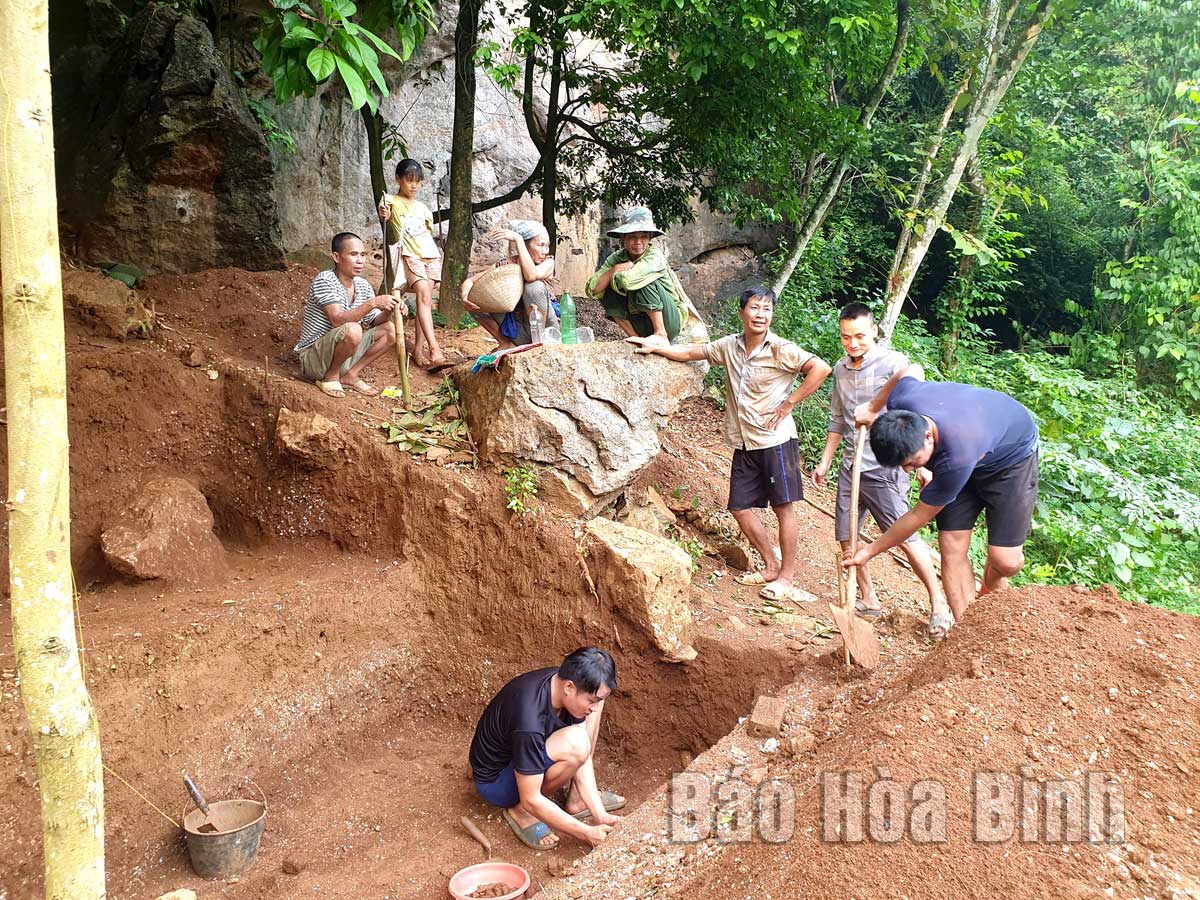
(HBO) – Hoa Binh province is currently home to more than 120 relic sites of the Hoa Binh Civilisation. There haven’t been any relic sites of this civilisation’s early period (about over 30,000 - 20,000 years ago) found in the province. While some sites date back to the middle period (over 20,000 - over 10,000 years ago), the majority belong to the late period of the civilisation (over 10,000 - 7,000 years ago).
An excavation team works at the Vanh Village stone
shelter relic site in Yen Phu commune of Lac Son district in 2022.
Relic sites of Hoa
Binh Civilisation’s middle period
The Trai Hamlet Cave relic site, located in Trai
hamlet of Tan Lap commune (Lac Son district), was discovered in 1980. The
Vietnam Institute of Archaeology carried out excavations there in May 1981 and
August 1982 and concluded that this is a typical relic site of the Hoa Binh
Civilisation. In 1997, this place was recognised as a national historical and
cultural relic site.
The Khoai Cave relic site in Khoai Mountain in
Sun hamlet of Xam Khoe commune (Mai Chau district) dates back to 17,000 -
11,000 years ago. It was listed as a national historical and cultural relic
site in 1997.
Dating back to 17,000 - 8,000 years ago, the
Vanh Village stone shelter in Trang Mountain of Vanh hamlet, Yen Phu commune
(Lac Son district), was found by French archaeologist M. Colani in 1929. Thanks
to its precious historical and scientific values, it earned the national
importance status in 2004.
Relic sites of Hoa
Binh Civilisation’s late period
Exploring Muoi Cave in Bua Ben Mountain of Man
Duc township (Tan Lac district), archaeologists have unearthed more than 900
objects and two graves there. The site, dating back to 10,000 - 7,000 years
ago, contains a wide range of vestiges typical for the late period of the Hoa
Binh Civilisation. It was recognised as a historical and cultural relic site in
1995.
Meanwhile, the Cho Cave relic site in Hui hamlet
of Cao Son commune (Luong Son district) was first excavated by M. Colani in
1926. Research findings revealed that it dates back about 10,000 years and was
a long-term living place of prehistoric humans. The cave was named a historical
and cultural relic site of national importance in 2000.
At Bung Cave in Suoi Hoa commune (Tan Lac
district), working tools and animal and plant traces found there indicate that
the site dates back over 10,000 years. It earned the national importance
recognition in 2003.
The Tam Cave relic site, located in Rong Tam
hamlet of Lam Son commune (Luong Son district), contains diverse work tools
typical for techniques used in the Hoa Binh Civilisation. Dating back to less
than 10,000 years ago, it was recognised as a national historical and cultural
relic site in 2000.
Dong Thot Cave in Ba Hang Doi township (Lac Thuy
district), dating back to about 10,000 - 7,000 years ago, was recognised as a
national historical and cultural relic site in 2001.
According to the Hoa Binh provincial Museum,
only 12 archaeological relic sites in the localities have been listed as
historical and cultural sites of national importance, including 10 belonging to
the Hoa Binh Civilisation. There remain a large number of relics that haven’t
studied, and it is necessary to have a long-term plan for the civilisation
research./.
As a land deeply intertwined with human history and Vietnam’s millennia-long journey of nation-building and defence, Hoa Binh is often revered for its epic tales and legends.
Residents of Hoa Binh boast a rich cultural identity, reflected in their unique language, traditional attire, customs, and folk melodies – described as "sweet as honey, clear as a mountain stream.”
Lac Son district’s Vu ban town held the 2025 Truong Kha temple festival on April 12–13 (the 15th–16th days of the third lunar month). Since its revival in 2019, the festival has been organised every three years, preserving valuable intangible heritage while meeting the community’s cultural and spiritual needs.
The clothing of women reflects the culture of the Muong, Thai, Tay, Dao, and Mong ethnic groups in the northern province of Hoa Binh.
Gongs hold a special place in the cultural and spiritual life of the Muong ethnic people in Hoa Binh province. More than musical instruments, they are an indispensable part of community rituals and collective memory, echoing through generations as a spiritual thread linking the past, present, and future.
Preserving and promoting the cultural values of the Muong ethnic group has become an urgent task in the current context, as many traditional values face the risk of fading away. This effort requires not only protecting the cultural identity but also eliminating outdated customs and developing a modern cultural lifestyle, contributing to sustainable values for the Muong community in Hoa Binh province.
The Muong ethnic culture, deeply rooted in Vietnam’s mountainous north, continues to be preserved and revitalised by dedicated individuals and communities determined to safeguard their ancestral identity.



